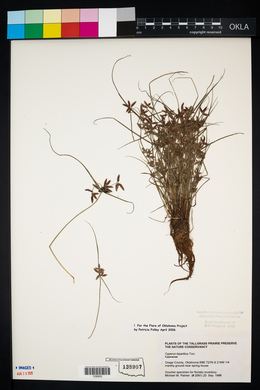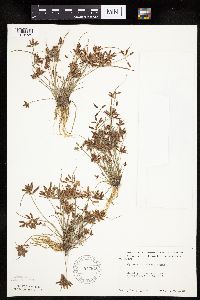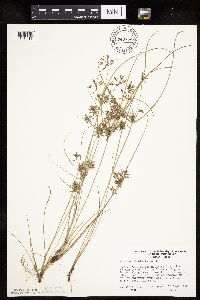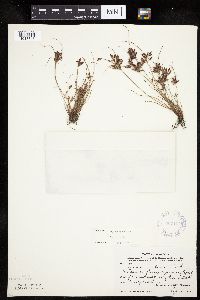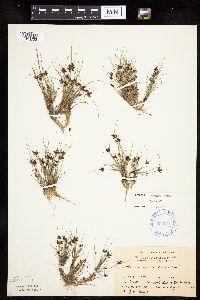Cyperus bipartitus
|
|
|
|
Family: Cyperaceae
Shining Flat Sedge, more...shining flatsedge, slender flatsedge
[Cyperus lagunetto Steud., moreCyperus niger var. rivularis (Kunth) V.E.Grant, Cyperus rivularis Kunth, Cyperus rivularis f. depauperatus (C.B.Clarke) Kük., Pycreus rivularis Palla] |
Herbs, annual, densely cespitose, with fibrous roots. Culms roundly trigonous, 3-25(-30) cm × 0.3-1.4 mm, glabrous. Leaves 1-3, V-shaped, 1-8 cm × 1-2 mm. Inflorescences: spike 1, loosely ovoid, compressed, 7-14 × 9-14 mm; rays 1-4, to 2(-3) cm; bracts 2-3, horizontal to ascending at 30(-45)°, V-shaped to flat, 1-12 cm × 0.5-1.5 mm. Spikelets 3-5(-8), flattened, oblong to oblong-lanceoloid, 8-18 × 2-2.6(-3) mm; floral scales (6-)10-26(-32), closely imbricate, laterally light to dark brown, medially light brown, laterally ribless, medially 2-3-ribbed, 2-keeled, oblong to ovate, 1.9-2.7 × 1.8-2.3 mm, apex obtuse. Flowers: stamens 2-3; anthers 0.4-0.5 mm, connective not prolonged; styles 0.6-1 mm; stigmas 1-1.5 mm. Achenes black, network of ridges forming isodiametric or square cells, sessile, obovoid to ovoid, 1-1.3(-1.5) × (0.6-)0.8 mm, apex apiculate, surfaces minutely punctate. Fruiting summer. Emergent shorelines, ditches, puddles, often in disturbed places; 0-1500 m; Ont., Que.; Ala., Ariz., Ark., Calif., Colo., Conn., Del., D.C., Ga., Ill., Ind., Iowa, Kans., Ky., La., Maine, Md., Mass., Mich., Minn., Miss., Mo., Nebr., Nev., N.H., N.J., N.Mex., N.Y., N.C., N.Dak., Ohio, Okla., Oreg., Pa., R.I., S.C., S.Dak., Tenn., Tex., Utah, Vt., Va., Wash., W.Va., Wis.; Mexico; Central America; South America. Annual herb with fibrous roots, densely tufted 1 - 25 cm tall Leaves: one to three, alternate, 1 - 8 cm long (usually shorter than culm), 1 - 3 mm wide, V-shaped in cross-section, linear, parallel-veined, keeled beneath, with a sheathing base that encloses the stem. Inflorescence: consisting of one or more terminal spikes, subtended by spirally arranged leafy bracts. Bracts two to three, horizontal to ascending, unequal, 1 - 12 cm long, 0.5 - 1.5 mm wide, flat or V-shaped in cross-section. Rays (branches of inflorescence) zero to five, to 2 cm long. Spikes stalked or stalkless, 7 - 14 mm long, 9 - 14 mm wide, loosely egg-shaped, compressed, consisting of three to ten spikelets. Flowers: minute, in the axil of a floral scale, lacking sepals and petals. Stamens two or three, exserted. Anthers about 0.5 mm long. Pistil one. Style to 1 mm long, two-cleft to about the middle, deciduous. Fruit: a one-seeded achene, stalkless, black, 1 - 1.5 mm long, about 0.5 mm wide, lenticular (lens-shaped) and egg-shaped or reverse egg-shaped with a small, slender point at the apex, tiny-dotted, with a network of ridges. Seed with a thin, non-adherent wall. Culm: 1 - 25 cm long, to about 1.5 mm wide, roundly triangular in cross-section, solid. Spikelets: 8 - 18 mm long, 2 - 3.5 mm wide, flattened, oblong to oblong lance-shaped, subtended by two small bracts, with ten to twenty-six floral scales. Scales spirally arranged and overlapping, becoming reddish brown, 2 - 2.5 mm long, about 2 mm wide, oblong to egg- lance-shaped with a blunt apex, two-keeled, two- to three-ribbed, lowest one empty. Similar species: No information at this time. Flowering: late July to late September Habitat and ecology: Common on muddy shores and in wet gravel or sand. Occurence in the Chicago region: native Etymology: Cyperus is the ancient Greek word for sedge. Bipartitus means two-parted. Author: The Morton Arboretum Tufted annual 1-2(-4) dm; cauline lvs 1-3 mm wide, usually shorter than the stem; spikes all sessile, or the 1-5 rays to 10 cm; spikelets 3-10, 8-15 נ2-3.5 mm; scales ovate, 2-2.5 mm, as seen from the side in half-view usually less than 3 times as long as wide, obtuse, and with the prominent midvein incurved distally to a somewhat cucullate tip, at maturity strongly red-brown from midrib to margin (less so distally), not sulcate; stamens 2(3); achenes lenticular, elliptic-obovate, 1-1.5 mm; style undivided in the basal third, deciduous. Wet ground, especially along shores; Me. and Que. to N.D., s. to Ga. and Tex. (C. niger var. castaneus; C. rivularis) Gleason, Henry A. & Cronquist, Arthur J. 1991. Manual of vascular plants of northeastern United States and adjacent Canada. lxxv + 910 pp. ©The New York Botanical Garden. All rights reserved. Used by permission. From Flora of Indiana (1940) by Charles C. Deam Rather frequent throughout the state in wet, sandy or gravelly soil on the borders of lakes and streams and on bars in ditches and small streams. |








